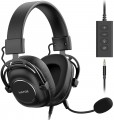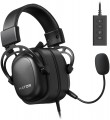Power
Headphone power is expressed in milliwatts (mW) - this figure can vary from a modest figure of 1 mW to an impressive level of 5000 mW. For the vast majority of headphones, power is not a decisive factor. In essence, this is an indicator of how loud the sound can be without the risk of damaging the drivers. At the same time, the parameter is important for some professional studio and audiophile models - in this case, power means the maximum audio signal level that is allowed to be supplied to the headphones from the sound source. If the headphones are used with a device that supplies too strong a signal, they may distort the sound or fail.
Sensitivity
Rated headphone sensitivity. Technically, this is the volume at which they sound when a certain standard signal from the amplifier is connected to them. Thus, sensitivity is one of the parameters that determine the overall volume of the headphones: the higher it is, the louder the sound will be with the same input signal level and other things being equal. However, we must not forget that the volume level also depends on the resistance (impedance, see above); moreover, it is worth choosing “ears” for a specific device first by impedance, and only then by sensitivity. In this case, one parameter can be compensated for by another: for example, a model with high resistance and high sensitivity can work even on a relatively weak amplifier.
As for specific figures, headphones with indicators of 100 dB or less are designed mainly for use in a quiet environment (in some similar models, the sensitivity
does not exceed 90 dB). For use on the street, in transport and other similar conditions, it is desirable to have more sensitive headphones — about
101 – 105 dB, or even
110 dB. And in some models, this figure can reach
116 – 120 dB. and even
more.
It is also worth noting that this parameter is relevant only for a wired connection according to the analogue standard — for example, via a 3.5 mm mini-
...jack. When using digital interfaces like USB and wireless channels like Bluetooth, the sound is processed in the built-in headphone converter, and if you plan to mainly use this kind of application, you can not pay much attention to sensitivity.Speaker size
The diameter of the speaker installed in the headphones; models with multiple drivers (see "Number of drivers"), usually, the size of the largest speaker is taken into account, other dimensions can be specified in the notes.
In general, this parameter is relevant primarily for over-ear headphones (see "Design"). In them, emitters can have different sizes; the larger it is, the more saturated the sound is and the better the speaker reproduces the bass, however, large emitters have a corresponding effect on the dimensions, weight and price of the headphones. But in-ear "ears" and earbuds, by definition, have very small speakers, and rich bass in them is achieved due to other design features.
In box
Among the equipment, it is worth highlighting
silicone and
polyurethane tips, relevant for in-ear headphones,
additional fixation nozzles and behind-the-
ear arms for better attachment in the ear,
interchangeable ear pads,
additional cable,
dongle,
aircraft adapter,
case / case and
docking station. There are also other accessories. More details about them:
- Silicone tips. Replaceable silicone tips used in in-ear headphones. Usually, several nozzles of different sizes are supplied in the kit, which allows you to adjust the headphones to a specific user. The practical advantages of silicone are softness, durability, general convenience and at the same time low cost.
- Polyurethane nozzles. Replacement tips for in-ear headphones made of foamed polyurethane. This material is somewhat more expensive than silicone, it requires regular cleaning and has a shorter service life - including due to deformation as it wears. On the other hand, polyurethane is ideal in terms of acoustics; it is these tips that are considered the best choice for lovers of in-ear “ears” with high-quality sound.
- Ear hooks. Removable devic
...es designed to additionally secure each earpiece to the ear. Note that such devices should not be confused with behind-the-ear mounts (see above). The main difference is that the arms are used exclusively in some models of in-ear headphones and earbuds as an additional option. In other words, you can wear such headphones without a bow, while the behind-the-ear mount is usually made non-removable and, in principle, you can’t do without it.
— Nozzles of additional fixation. Auxiliary caps for a tighter fit of the in-ear headphones. They are used to provide better fixation of headphones during sports or provide additional volume to users with a large auricle.
- Replaceable ear pads. Comes with interchangeable ear tips. In general, the ear pads are the part with which the headphones come into contact with the listener's ears. In full-size and on-ear headphones, they are soft pads on the inside of the cups.
— Case (case) / cover. Covers are usually called soft rag bags, they protect the "ears" mainly from pollution and take up a minimum of space. Cases are made of hard materials, they are a little more bulky, but they protect well from shock, pressure and contact with sharp objects. In any case, the complete case or case is optimally suited for the headphones and is more convenient than an impromptu protective casing.
- Charging case. Case - a case made of hard material - simultaneously playing the role of a charger. This feature is very popular on true wireless models (see "Cable Type"). The charging case usually has its own battery and the headphones are already charged from this battery; this design provides additional convenience in several moments at once. Firstly, the case, in fact, also performs the function of a power bank - an autonomous power source; the capacity of such a “power bank” may be different, but it is usually enough for several full charges of the “ears” (for more details, see “Capacity of the case”). Secondly, the ability to charge the headphones directly in the case reduces the risk of losing them. Thirdly, the charging procedure itself is quite convenient - just connect the cable to the case.
- Dock station. Stationary stand with the possibility of placing headphones and contacts for charging them. Also, docking stations are often used to transfer the sound track to headphones - they are connected directly to the sound source via a wire, and the sound is transmitted to the ears wirelessly within a certain radius of action.
— Clip for carrying. A clip designed to fasten the wire to a pocket, collar, lapel of clothing, etc. It provides additional convenience: thanks to the clip, the wire does not hang out, the likelihood of touching it with careless movement or catching on the surrounding object is reduced.
- Additional cable. An additional cable provided in addition to the main one may have different features and specializations. So, complete cables can vary in length, connector type, wire type, additional equipment (microphone, volume control), etc. These details should be specified separately in each case. Here, we note that almost all headphones with this configuration have a detachable cable (it makes sense to supplement a non-detachable wire with an extension cable, and it is considered a separate accessory - see below).
- Extension. A type of additional cable designed solely to increase the overall length of the wire. Due to the extension cord, you can adjust the headphones to the specifics of the situation: for example, “build up” the cable if you need to switch from a laptop to a TV or a stationary audio system.
— Airplane adapter. Dedicated headphone adapter for use with modern airliner entertainment systems. In such systems, a special way of connecting headphones is used - through two 3.5 mm jacks (and we are talking about classic "ears", without a microphone). Models with a traditional single 3.5 mm plug can only be connected to this output through an adapter; such adapters may initially be included in the delivery.
- Windproof microphone. Devices in the form of a foam rubber or "shaggy" lining on the headphone microphone capsule. Cut off unnecessary ambient noise and minimize the effect of direct exposure to air currents on the microphone, which can cause interference in speech transmission.
— Dongle. The dongle is used to simplify the organization of connecting wireless headphones to other devices. In fact, this is a radio transmitter (less often a Bluetooth transmitter) that non-contactly broadcasts sound to headphones from a connected device.
This list is not exhaustive and may include other optional items.
